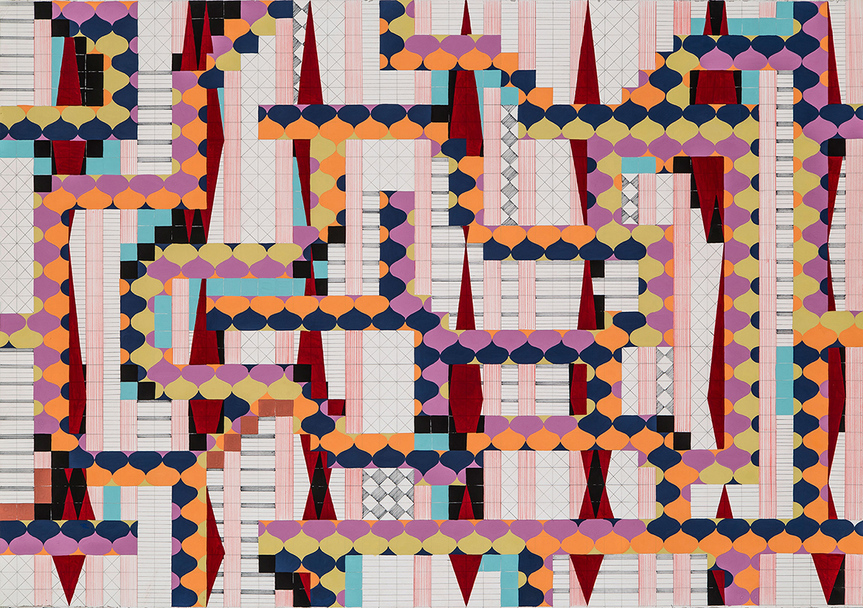-
From Current Issue
-
- Editor’s Letter Fire in the Heart
- Reviews I Gusti Ayu Kadek Murniasih
- Reviews 11th Seoul Mediacity Biennale: “One Escape at a Time”
- Dispatch Networked China
- One on One Monira Al Qadiri on Yukio Mishima
- Essays The rise of independent art spaces in pandemic-era Shanghai
- Features Tuan Andrew Nguyen
- Table of Contents
- Web Exclusives
- Archive
- Subscribe

R
E
V N
E
X
T
Installation view of NARGESS HASHEMI’s “I Will Build a Tall City Interconnected by Cul-de-Sacs,” at Gallery Isabelle van den Eynde, Dubai, 2018. All images courtesy the artist and Gallery Isabelle van den Eynde, Dubai.
I Will Build a Tall City Interconnected by Cul-de-sacs
Nargess Hashemi
The possibilities of a utopia—a term first coined by Renaissance philosopher Thomas More in his satirical book of the same title published over 500 years ago, which has come to mean, in common parlance, a place of equality, unity and contentment—appears more elusive now than ever. Economic inequality, social alienation and brutal armed conflicts across the earth are the emblematic, dominant features of contemporary life, making the existence of a society where order and parity reigns exceedingly unlikely. But what if that is because we have been thinking about it in the wrong way? In artist Nargess Hashemi’s fourth solo exhibition at Gallery Isabelle van den Eynde, she offered her approach. Her utopia is a place of interconnection, with the lines between public and private realms blurred and fluid, and where ecology, work, family and leisure are united under one human experience.
Hashemi’s abstract, geometric blueprints, rendered with mixed media and collaged materials on paper and canvas, map such imaginary, human-centric cities—places that unite rather than divide. These urban plans were created with the coexistence of different groups of people in mind, and are depicted from varying distances, ranging from 100 meters to five kilometers, to show viewers how everything is connected to serve these communities. Satellite View from 500 m – Housing Complex for Crafts People and the Research of Handicraft (2017), for example, features culturally diverse homes, represented by whimsical symbols such
as hearts, stars and geometric flowers. The images are visually beautiful, but the true poignancy of the works come after deciphering the checkerboards of colored pixels protruding between the homes, signifying cultural and education centers, solar energy facilities, as well as places for ecological study. For Hashemi, all aspects of life—the pragmatic, intellectual and spiritual—are intertwined, evidencing the humanistic qualities of her vision
of utopia.
Further detailing the connections between the spaces in her plans were Hashemi’s large, knitted macramé installations. Breathing House (2017) is a four-meter-tall crocheted structure with two adjacent walls, designed to not fully separate the inhabitants of the
spaces, but instead give them privacy while keeping them connected to their community. On the other hand, her focus on ecology and sustainability result in the use of plastic bottles to give shape to the 2018 work Breathing House, in which the squares of her urban
plans are made tangible through wool yarn. The textile-based pieces were made by a community of women close to Hashemi. It is this involvement of the collective, both as the inspiration and in the creation of these works, that makes Hashemi’s exhibition so hopeful and optimistic.
Perhaps more interesting yet within the show was her treatment of the marginalized—something that contemporary society does very poorly. Satellite View from 500 m – Complex for Rehabilitation of Immigrants (2017) is a sherbet-hued maze of service centers, residential complexes, water features and cul-de-sacs, all speaking to an interpretation of rehabilitation that is empowering instead of punitive. Zooming in, Satellite View from 100 m – Temporary Residency for War Refugees (2017) applies the same planning language to propose
an increased use of natural resources within the community. In Satellite View from 500 m – Cultural City for the Less Privileged (2017), people live surrounded by nature and culture. Green and blue pixels, representing natural features, embrace housing complexes as well as medical and cultural facilities. These are undoubtedly places of life—a stark contrast to the bleak refugee camps and urban ghettos, which have too often been the modern solutions to these problems. What a world we would live in should Hashemi be the master planner.
Nargess Hashemi’s “I Will Build a Tall City Interconnected by Cul-de-Sacs” is on view at Gallery Isabelle van den Eynde, Dubai, until
July 26.
To read more of ArtAsiaPacific’s articles, visit our Digital Library.







